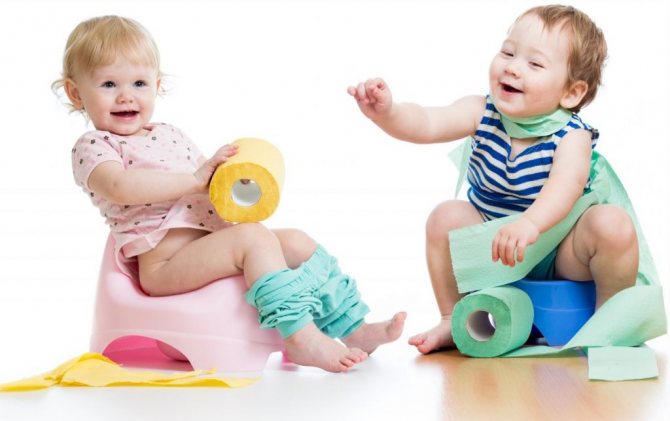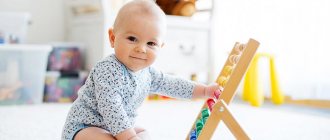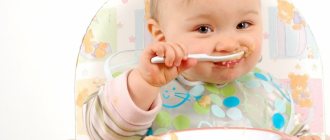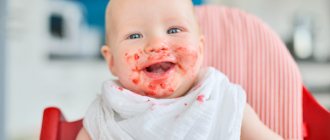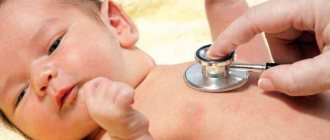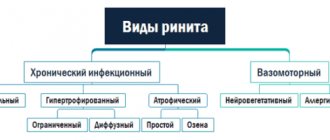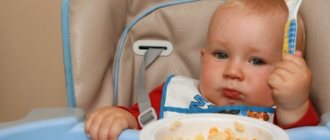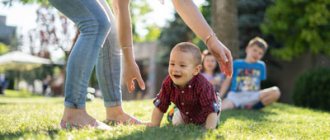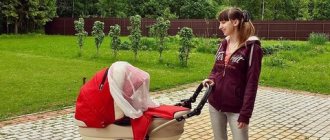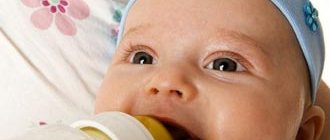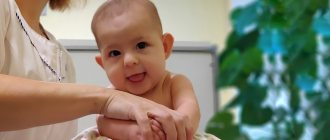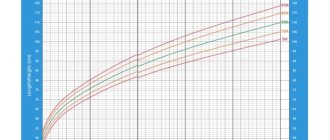At 1 year and 4 months, the child begins to actively express himself as an individual and become aware of his own desires.
Young mothers among themselves call this age the peak of whims.
The baby’s mood becomes wave-like - a minute ago he was laughing, but now he’s crying.
Pickiness in food and entertainment appears. How to cope with this little tomboy and what do you need to know about his development?
Let's find out!
Physical parameters per year and four
| Gender of the child | Height | Head circumference | Weight | Teeth | Chest circumference | Vision |
| Boy | 78 cm | 49 cm | 11.5 kg | Upper canines and first molars erupt | 47.3 cm | Physically caused farsightedness is still present, which will completely disappear by 3-5 years. |
| Girl | 83 cm | 45.5 cm | 10.6 kg | 53.1 cm |
What can a baby do?
By the age of 1 year and 4 months, the child develops the following skills:
Gross motor skills
- Walks independently - the baby already knows how to move without assistance. The legs and arms are spread wide apart to maintain balance.
- Rises from a lying and sitting position - without outside help or support.
- He sits down from a standing position - so far it looks somewhat awkward. The child just suddenly falls on his butt.
- Crawls up and down the stairs - while going down on all fours.
- Carries a large toy or several small ones in his hands.
- Rolls a car behind him on a string or pushes a toy with a long handle in front of him.
Fine motor skills
- Builds a tower from cubes or rings.
- He opens the lid of the box and turns it over to shake out the contents.
- Throws toys into a box.
Vision
He continuously watches what is happening , points his finger at objects that interest him.
Eating food
- Drinks from a sippy cup without assistance.
- Tries to eat with a spoon on his own.
- Chews food cut into pieces.
- Eats soft foods on his own - fruits, baby cookies, etc.
Hygiene
- He loves to bathe and tries to soap his hands and feet with a bar of soap or a washcloth.
- He tries to dry himself with a towel.
Dressing
- Takes off socks, unbuttoned shoes and slippers independently.
- Removes the headdress if it is not tied.
- Helps an adult dress himself.
Ability to focus attention
- He waits until the interlocutor finishes, and then answers him using gestures, short words and facial expressions.
- He follows with his gaze where the interlocutor points his finger and finds the pointed object.
- Imitates the actions of others, trying to reproduce them in his games.
- Pays attention to the illustrations in the book - tries to name what is depicted in them.
- Moves to the beat of the music, tries to dance.
Speech and gesture perception
- Points his finger at household members and objects - can show where mom, dad, cat, teddy bear, etc.
- Names objects from books at the request of an adult or independently.
- Expressing sympathy and affection
- When upset, he comes to hug an adult to get emotional support.
- Selects his favorite toy from others and takes it with him everywhere.
- He does not like to be among strangers, he tries to find a familiar person with his eyes as soon as possible and approach him.
- Likes to listen to the same fairy tale several times, watch cartoons, etc.
Play activity
- Understands the purpose of everyday objects and demonstrates this knowledge in games. For example, he feeds a bear from a plate, carries a doll in a car, etc. In games, cause-and-effect relationships begin to be traced.
- Pretends and imitates - pretends to be asleep, or is about to go outside. Imitates the actions and gestures of adults.
- Likes to play games that involve taking turns - taking turns throwing a ball, drawing, etc.
- Begins to draw with finger paints, crayons, and pencils. Moves the pencil sweepingly and expressively.
- Imitates sounds to represent an object or animal. A car – “beep”, a cat – “meow”, a dog – “aw-aw”, etc.
What should a child be able to do at 16 months?
Active movements of the child become the norm. He still falls quite often, but can now overcome short distances without the help of his parents. Children at 1 year 4 months master the vertical plane, climbing onto chairs, stools, tables. Children of this age go up and down stairs.
The level of development of fine motor skills is such that the child can easily control a spoon while eating and drinks from a mug independently.
Speech continues to form. He pronounces most consonant sounds and tries to speak.
Household skills of children aged 1 year 4 months:
- eats independently with a spoon, holding it in his fist;
- uses the potty independently or with the help of adults;
- washes hands and face.
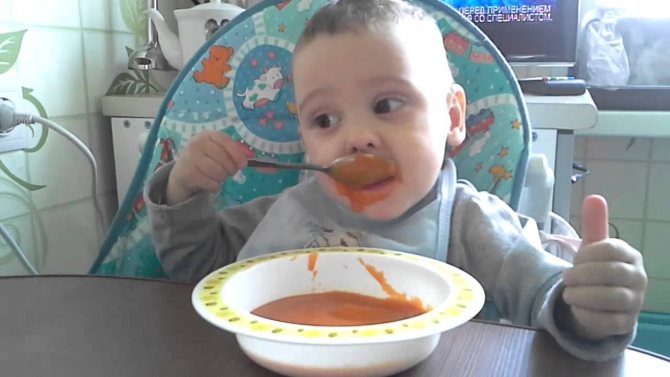
The more time parents devote to their baby, the more skills he masters. A properly developing 16-month-old baby has taste preferences, understands his gender (boy-girl), knows how to express his desires, and understands the words dos and don’ts.
Features of the psycho-emotional sphere
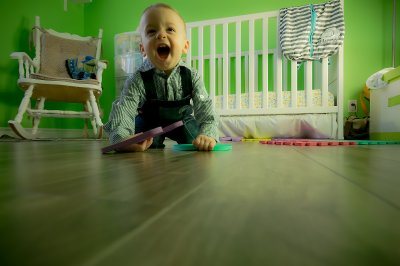
He begins to feel the mood of adults and caresses when he sees that someone is sad or is demonstrably “sad” for the company.
Girls are more responsive to emotional contact - they like to hug, receive affection, and sit in arms.
Boys prefer contact entertainment with tickling, hide and seek and everything that causes fun. They know how to be surprised by unexpected things and laugh at absurd situations - when someone falls awkwardly, or deliberately puts a shoe on their head, etc.
Reference! At the age of 16 months, children often cry “collectively”, that is, if one child in their group fell and cried, the others will also begin to act up.
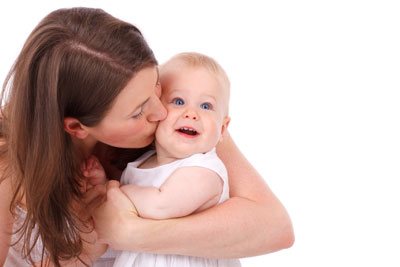
A favorite toy appears, which the baby carries with him everywhere and puts him to sleep in his crib, a favorite book that is leafed through over and over again, a favorite cartoon, a game.
Due to his desire to constantly be close to the object of affection, the child may urgently ask to go to his parents’ bed or run to them under the covers in the middle of the night.
It is important to wean your baby off this habit as soon as possible and instill in him a love of sleeping in his crib.
The child begins to convey his emotions and feelings through facial expressions and gestures, and reacts differently to familiar and unfamiliar people. Pointing his finger at an object, he makes sounds or simple words like “give” to get what he wants or to hear the name of the object that interests him.
Kids who are bolder gradually switch from solitary games to joint ones, initiating communication with other kids on the playground. Here another newfound character trait comes to the surface - a sense of ownership. A child at this age for the first time encounters the fact that other children want to play with his favorite toy and often does not know how to react to this, which causes bouts of crying and aggression.
Child at 1 year and 4 months: development, psychomotor features
A child at 1 year and 4 months begins to actively show his character. 1 year and 4 months can be called the most capricious in the development of a baby: he independently chooses the food he wants, but can enjoy a couple of spoons and immediately reject the food. Now your child is changeable, like the weather in England, so parents need to be patient and carefully monitor the baby’s preferences. Don’t be surprised if your child refuses his previously favorite puree and happily eats soup that he previously thought tasteless.
By 1 year and 4 months, the baby has developed a certain feeding schedule: he may not have an appetite during the hours when he was fed before, so now you will have to build on his preferences. Of course, parents begin to worry about the question: what if a child is malnourished, does his body receive less nutrients that are necessary for full development? – There is no need to worry, scientists have conducted a lot of research, the results of which have confirmed that at this age the child’s body itself knows what it lacks, and therefore requires certain food. No child who is offered a variety of foods will go hungry. Parents just need to understand what the child wants and offer him more food of this type. After satiation, he will easily switch to another food. The main thing is that you don’t need to try to push as much food into your son or daughter as possible and respond adequately to whims.
A child at 1 year 4 months begins to actively assert himself and enter society. Just don’t indulge all your whims just yet, although the word “no” will be heard more and more often, at this age children use pointing gestures more actively and develop quickly.
1 year and 4 months for a child is the period when the lateral incisors begin to erupt, so your child may be capricious at night - stock up on pain-relieving gels for the gums. At this age, children may continue to put everything in their mouth, since itching in the gums is unpleasant.
Child at 1 year 4 months : child’s intellectual development
At 16 months, a child’s brain is very active: his vocabulary is expanding, but his actions are still imitative. Despite his apparent independence, the baby loves to imitate the actions of adults; his games take on a special character. You can easily ask your little one to help you tidy up the toys (find them, bring them) - it will be useful for development, and it will be easier for you. Most often, children at this age play with concentration, without asking adults for help. They are happy if something worked out and are upset if the tower they built from cubes fell apart.
Child aged 1 year 4 months : psychomotor features
- The child becomes more independent and capricious; the period from 1 to 2 years is generally very difficult for parents, but you will definitely cope;
- The baby learns to undress and dress with minimal help from adults:
- If you give him a pencil or felt-tip pen, he begins to draw zigzags, open ovals and other shapes;
- A 16-month-old child is good at comparing the concepts of “big” and “small”; he can already put proportionate figures in suitable cups or windows, and builds towers from cubes;
- Children of this age already walk more confidently, go around obstacles, pull toys on a string or push a stroller;
- While eating, the child holds the spoon in his fist and learns, under the supervision of his parents, to use a fork;
- At the request of an adult, the child can point with his hand or bring objects familiar to him.
Speech
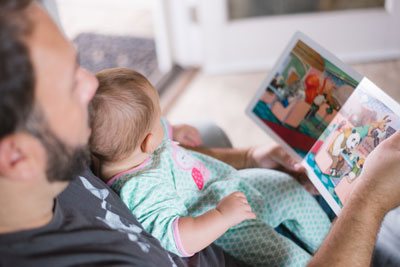
For example, when he sees a dog, he points his finger at it and says “aw-aw”, waiting for confirmation from adults.
Can ask for assistance by pointing to the desired object and repeating “give”, “drink”, “yum”, etc.
He loves educational activities in which he needs to repeat and finish simple babbling sounds after an adult.
During independent play, he also simulates sounds and words, accompanying what is happening, for example: when playing with a car, the baby will voice its movement with a drawn-out “vzhzh.”
Speech becomes more emotionally charged - the child uses facial expressions, gestures and begins to express his mood with voice intonation. He becomes visibly upset when he doesn't get what he wants and expresses delight during fun games.
Physiological features
Indicators of the physiological development of the baby - weight, height. They are individual, but averaged parameters are used for evaluation.
| Parameter | Girl | Boy |
| Height (cm) | 77-78,5 | 79,5-81 |
| Weight, kg) | 10,3-11 | 11-11,3 |
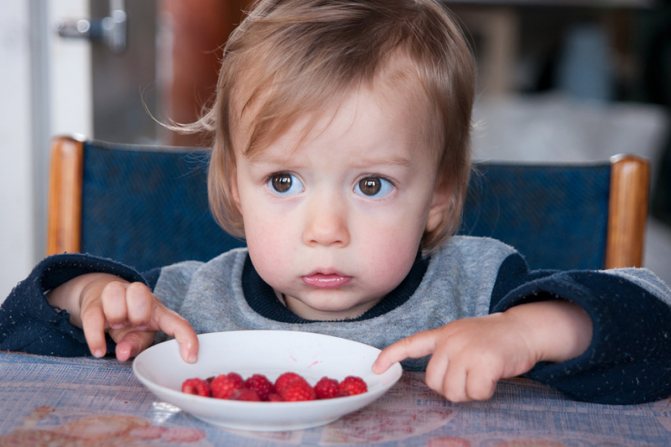
Babies eat a varied diet and the number of teeth increases. Fangs are erupting. Their appearance causes discomfort, they grow for a long time and painfully. The first molars may erupt during this period.
Emotional development
The baby begins to develop the skills of his first social relationships. He emotionally expresses sympathy and empathizes with others. Learns to express feelings while playing with dolls and soft toys. Copies the behavior of adults:
- feeds;
- rocks, hugs;
- carries in his arms.
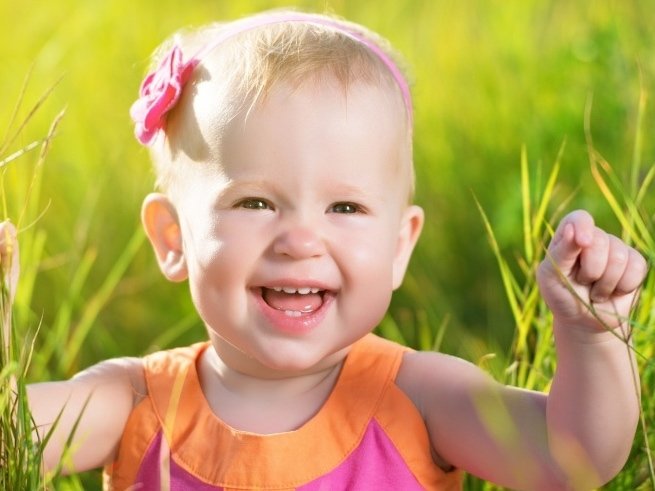
Children during this period are emotionally sensitive. They are afraid of unexpected actions, they can cry and laugh for company.
Intellectual development
The child understands more and more words, this facilitates the process of communication and education. You can ask him to hand over something and put it in its place. He is able to clearly express his agreement (disagreement). Expresses this with affirmative or negative nods of the head. Reading becomes fun. The child happily points his finger at pictures with animals, berries, household items, and cars in response to an adult’s question. The number of words spoken at this age can range from 10 to 50.
The child undergoes intensive brain development:
- memory begins to develop;
- the concept of shape, color, distance appears;
- The baby learns to estimate the size of objects.
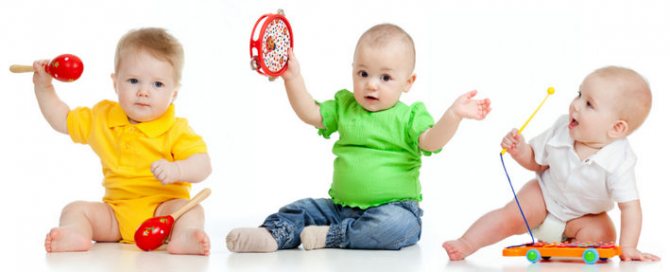
Diet at 16 months: what to prepare for your baby?
At this age, you can gradually move from 5 meals a day to 3-4 meals a day . Since the baby already knows how to chew hard pieces of food, the diet can be diversified with vegetable salads, dishes with pieces of meat, and baby cookies.
Sample menu
| meal | List of dishes |
| Breakfast | Porridge with milk, cookies, milk. |
| Dinner | Soup, buckwheat porridge and vegetable salad, fruit drink. |
| Afternoon snack | Cottage cheese, a piece of banana, children's cookies, tea. |
| Dinner | Vegetable puree or porridge, tea with milk. |
Dish recipes
Tender beef tongue puree
You will need:
- boiled tongue – 200 grams;
- meat broth - 1 cup.
Preparation: remove the skin from the boiled tongue, cut into small cubes and place in a blender bowl. Pour in the broth and grind until smooth. Serve with vegetables or mashed potatoes.
Zucchini soup puree
You will need:
- zucchini – half of a medium-sized vegetable;
- potatoes – 4 pcs.;
- chicken leg – 1 pc.;
- water;
- salt.
Preparation: boil chicken broth on the ham, remove the ham, peel the meat from the skin and bones and throw it back into the pan. Cut the potatoes and zucchini into cubes and add to the broth. Cook until the vegetables are ready, and then pass through a blender.
Features of care
Hygiene procedures are an important element of the daily routine. Washing your face in the morning helps you wake up, and taking an evening bath helps you fall asleep.
It is very important to teach your baby to wash his hands upon returning from a walk and before eating, since at this stage of life his curiosity knows no bounds and anything can end up in his little hands.
Another new, but important stage for the baby is brushing his teeth. Let's look at it in more detail.
Teeth cleaning
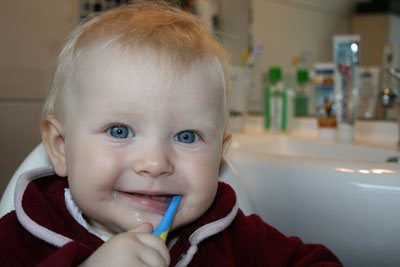
Some toddlers perceive this process with enthusiasm and ask for a brush themselves, while others, on the contrary, resist and try in every possible way to evade the unpleasant procedure.
You can solve this problem with the help of flavored children's toothpaste in a bright bottle and a brush. Try to reinforce in your child’s subconscious that brushing teeth is fun and interesting.
If your baby reaches for a toothbrush on his own, don’t forbid him; let him try to brush his teeth, but make sure that he doesn’t accidentally touch the uvula with the brush and vomit.
Important! A children's toothbrush is half the size and softer than a classic one. The area of the bristles should be equal to the area of two small children's teeth (1-1.5 cm).
Features of this age
The child observes the people around him with great interest; he copies their behavior. He develops new everyday and behavioral skills, they can be positive and negative:
- wipes dirty hands, asks to wash them;
- expressing disagreement, tries to hit.
During this period, it is important to praise the baby for good deeds, to show with facial expressions and words that you are upset by his bad behavior.
Day and sleep routine
Routine is still an important component of the life of a sixteen-month-old child. It helps him maintain energy throughout the day and teaches him to understand cause and effect relationships.
An approximate daily routine for a child of this age is as follows:
| Times of Day | Class |
| 7:00 – 8:00 | awakening |
| 8:30 – 9:00 | breakfast |
| 9:30 – 11:30 | morning walk |
| 12:00 – 13:00 | dinner |
| 13:00 – 16:00 | afternoon nap |
| 16:00 -17:00 | educational games |
| 17:00 – 17:30 | afternoon tea |
| 17:30 – 18:30 | an evening walk |
| 19:00 – 19:30 | dinner |
| 20:00-20:30 | bathing before bed |
| 21:00 – 7:00 | dream |
Activities with your baby
Games are one of the priority ways for a sixteen-month-old child to learn. They captivate the baby, and he quickly remembers new words and masters new skills.
Games
- Development of fine motor skills - handling fabrics with different textures and densities in the hands, modeling from plasticine and sand, drawing with finger paints.
- Speech development - joint reading of illustrated books, cards with pictures, guessing colors, pointing to an object (show where dad, mom, cat, etc.).
- Games for coordination of movements and logic - large and small boxes in which you can put objects, pyramids of bagels and cubes, cups inserted into each other, stringing beads on a thread are suitable for this.
- Games with tactile contact - tickling, hide and seek.
Toys
- For role-playing and story games - cars, dolls, animals, dishes, household items (iron, mop).
- For the development of motor skills - pyramids, cubes, sandbox molds, kinetic sand, textured toys, mosaics and construction sets with large parts.
- For speech development - “talking” toys, illustrated books with fairy tales, cards with pictures.
When choosing toys, consider your child's preferences. For example, girls often like to play story games with toys, while boys, on the contrary, do not like to concentrate on something for a long time, but enjoy spending time actively playing ball or cars.
Our website also contains materials about the following periods of babies’ lives: one year and 5 months, one year and 6 months, one year and 7 months, one year and 8 months, one year and 9 months, one year and 10 months, one year and 11 months.
Physical development
At this age, children go through a period of active physical development. They strive to learn how to control their body in different ways: they try to dance, actively imitate the gestures of their loved ones, jump, etc.
Attention should be paid to the child’s fine motor skills and the development of his vocabulary - at this age, children strive in every possible way to become like adults and carefully monitor and imitate them.
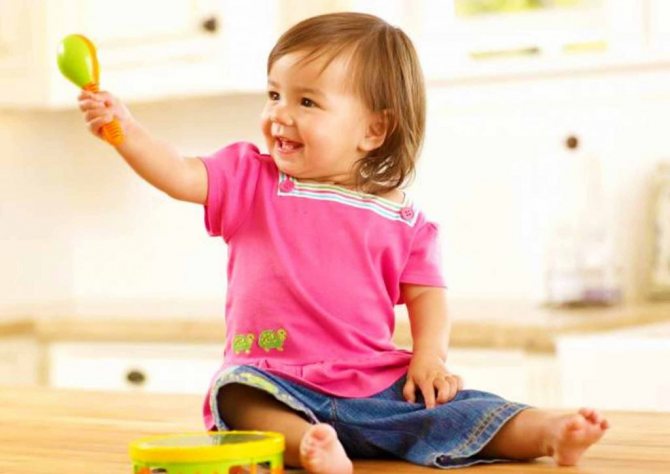
Skills that most children have at this age:
- Walking independently or with minimal assistance;
- Stepping over obstacles with support from something or independently;
- Attempts to hold a spoon and eat without any help;
- Show, bring, serve items at the request of elders.
In one year and four months, a child may develop several teeth, the care of which is very important. Doctors strongly recommend starting careful brushing of teeth from the very moment they appear, this will avoid future problems with teaching a child to oral hygiene, as well as problems with caries and other dental diseases.
But you shouldn’t buy toothpaste too early, because... through carelessness and ignorance, children can swallow it; It will be enough to use a special silicone finger brush.
At the age of sixteen months, it is important to begin potty training your child, gradually getting rid of wearing diapers. If you miss this moment, then in the future it will be very difficult to teach him to respond to the desire to go potty.
